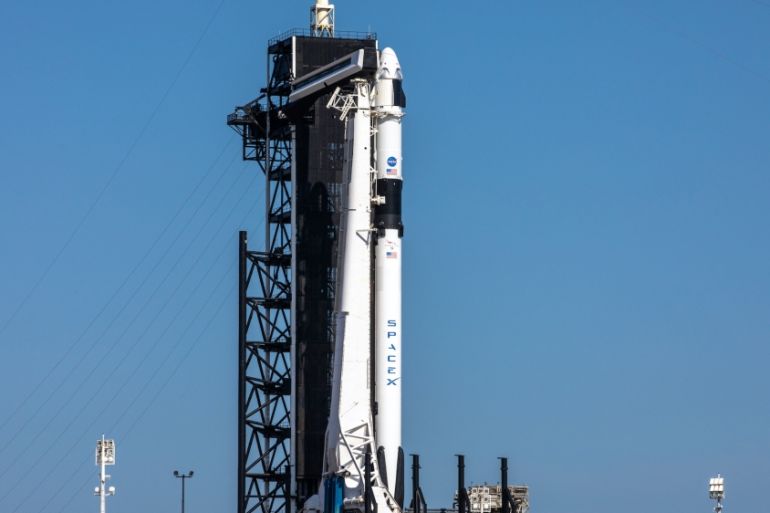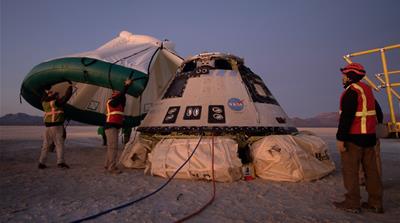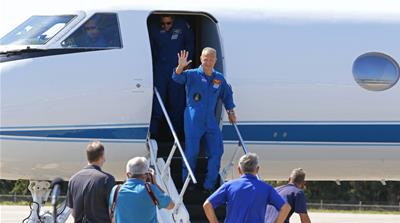SpaceX counts down to historic Crew Dragon astronaut launch
Weather permitting, Elon Musk’s rocket company is set to snatch the prize from rival Boeing, at half the price.

Billionaire entrepreneur Elon Musk’s rocket company, SpaceX, is just hours away from becoming the first-ever commercial entity to launch humans into orbit and then take them to the International Space Station (ISS).
“We’re continuing to tick off our pre-flight readiness checklist,” said Kathryn Lueders, program manager for NASA’s Commercial Crew Program, at a news conference on Monday. “All the teams are ‘go’.”
Keep reading
list of 4 itemsPhotos: Mexico, US, Canada mesmerised by rare total solar eclipse
Moment total solar eclipse occurs in North America
Millions across North America await total solar eclipse
“And we’re continuing to make progress towards our mission. And now, the only thing we need to do is figure out how to control the weather,” Lueders said.
If successful, when the Demo-2 mission blasts off from Launch Complex 39A at the Kennedy Space Center in Florida at 20:33 GMT on Wednesday, it will launch the United States into a new, commercial era of spaceflight.
Demo-2 will also crack open the human spaceflight domain that has been the sole preserve of rival Boeing Co, the storied aerospace giant.
On Monday, forecasters from the US Space Force’s 45th Space Wing concluded that there was a 60-percent chance that the SpaceX Crew Dragon launch would blast off on time, if thunderstorms cleared and the wind died down.
“It’s really a dynamic situation that’s developing across Florida,” said Mike McAleenan, the space wing’s launch weather officer, at the same news conference. “We have some hope for launch day.”
In spite of the tricky weather outlook, NASA and SpaceX on Monday wrapped the final readiness review before Wednesday’s scheduled test launch of two astronauts.
The Demo-2 mission is the final major test before NASA certifies the company’s Crew Dragon spacecraft for regular human transport missions to the ISS.
SpaceX vs Boeing
Boeing, SpaceX’s direct competitor in NASA’s Commercial Crew Program, has suffered a series of failures that have held the company back from keeping pace.
More than two years behind schedule, SpaceX is nevertheless delivering the Crew Dragon spacecraft and launch system for roughly $2.6bn, while Boeing has taken in some $4.2bn for its troubled Starliner effort. Last November, US Vice President Mike Pence told the two companies they had until this spring to launch astronauts into orbit.

In December, bad software coding caused the Boeing Starliner capsule to fail to reach the correct orbit, forcing the company to forego a key test and contractual milestone – a rendezvous and docking with the ISS. Just before returning the capsule to Earth, Boeing personnel discovered more bad code which, if it had gone undetected, may have caused the loss of the spacecraft.
Less than a month later, in January, SpaceX blew up one of its own rockets to prove, in an uncrewed “in-flight abort” test, that the Crew Dragon system can detect a fatal in-flight event and whisk astronauts away from danger. That milestone paved the way to this Wednesday’s launch, which could upset Boeing’s presumed spaceflight supremacy.
That same month, Boeing told investors in a fourth-quarter earnings call that the company was taking a $410m pre-tax charge to find and fix the Starliner issues and perform another uncrewed test.
‘Cheap’ seats
The 15-year journey that has brought SpaceX to this historic juncture started as an idea and $500m in taxpayer money to incentivise the private sector into developing a commercially viable cargo launch service to the International Space Station.
In 2005, then-NASA Administrator Mike Griffin’s vision was that once companies had mastered cargo flights to the ISS, they should go on to develop the capability to launch humans.
What was unforeseen at the time was that in six years NASA would cease using the Space Shuttle. With no human-rated US-made spacecraft in the pipeline, NASA had to rely on the only other space agency capable of sending humans into space – Russia’s Roscosmos.
As it was a sole-source market, it cost NASA a cool $85.4m per seat on a Soyuz rocket. Since 2017, the year Commercial Crew should have launched, NASA has shelled out more than $1bn to send US astronauts to the ISS, according to a NASA inspector general report.
Even before the coronavirus took a bite out of the US economy and therefore the government’s budget, NASA repeatedly said it needed “reliable and cost-effective access to and from the International Space Station”.
The estimated price for a Crew Dragon seat is roughly $55m, while a seat on Starliner is thought to be about $90m.
Hans Koenigsmann, vice president, for SpaceX’s Build and Flight Reliability division, said: “We spent many years in development. An incredible amount of testing.”
He added, “There was a lot of urgent and important work done over the last couple of months, the years … There are no show-stoppers. Everything is looking good.”
In the beginning, Sierra Nevada Company and Blue Origin, in addition to Boeing and SpaceX, attempted to provide cargo services. In 2014, only SpaceX and Boeing made the final cut to develop spacecraft and launch systems for the Commercial Crew Program.
More than one ‘first’
Wednesday’s launch will be only the fifth time that NASA astronauts have launched in a new US-made vehicle. Crew Dragon, sitting atop the 23-story-tall Falcon-9 rocket, will join the ranks of Mercury, Gemini, Apollo, and the Space Shuttle, that is if all goes according to plan.

“I would say it’s something maybe we dreamed about, flying something other than a Shuttle, the next vehicle. It did not seem likely at the time when we arrived in the astronaut office,” said NASA astronaut Bob Behnken on Friday in his last news conference before the Demo-2 launch.
“We’ve longed to be part of a test mission, a test space flight,” he said.
It has been just under nine years since astronauts landed the Space Shuttle Atlantis at the Kennedy Space Center, completing mission STS-135, and ending that vehicle programme’s 30 years of service.
Now Behnken and fellow astronaut Doug Hurley, who have been in quarantine for more than three weeks, are spending their last day and hours before launch taking in technical briefings, having medical checks and spending time with their families.
After launch, weather permitting, it will take 19 hours for the Crew Dragon to reach the ISS. Once Hurley and Behnken reach the ISS, they are expected to stay there anywhere from six weeks to three months before returning.